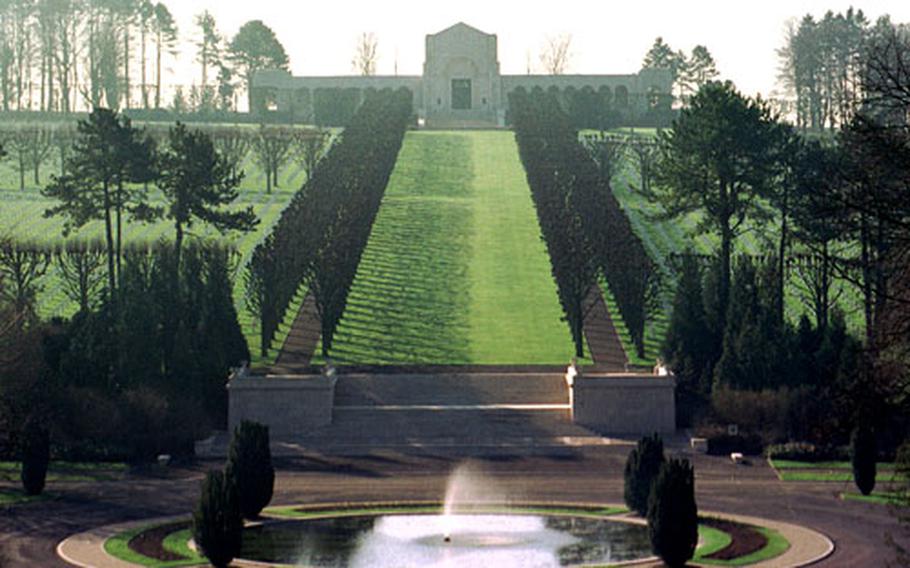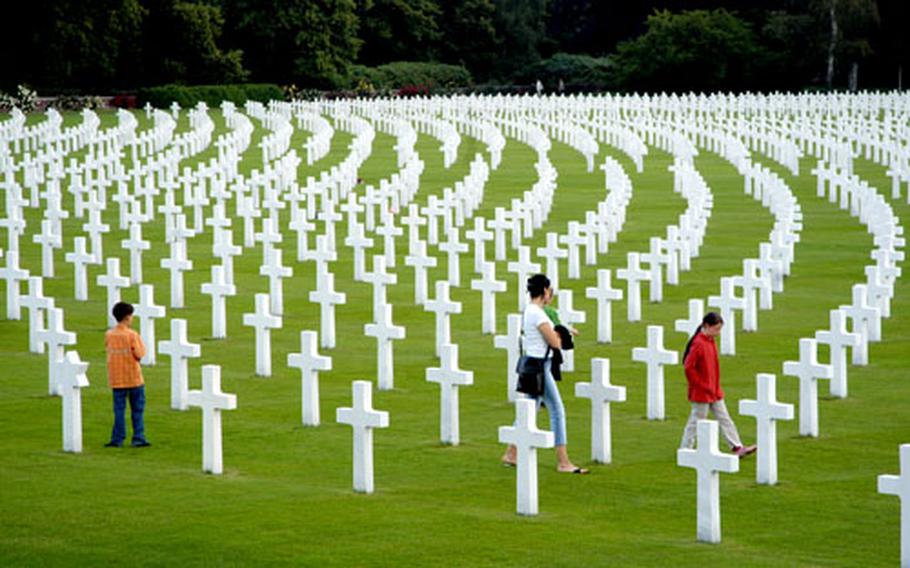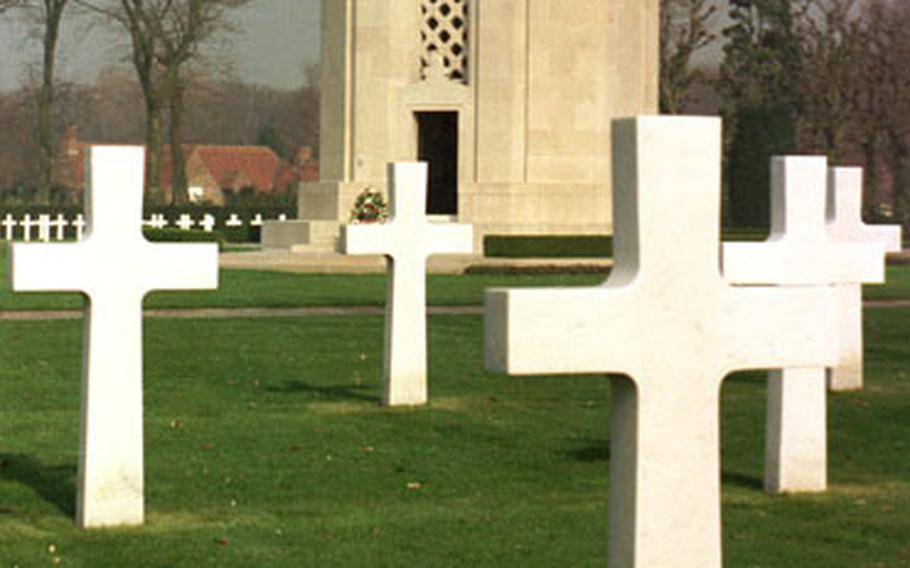Rows of crosses and Stars of David stand in long rows at Normandy American Cemetery, Colleville-sur-Mer, France, decorated with American and French flags. The cemetery is the final resting place for 9,386 of our war dead. (Michael Abrams/Stars and Stripes)
It is hallowed ground.
Here in the sod of Europe lie thousands of Americans who made the ultimate sacrifice for their country in two World Wars.
They are buried, row upon row, under simple white crosses or Stars of David in cemeteries in Belgium, England, France, Luxembourg, Italy and the Netherlands.
They died far from home in battles and operations known as Belleau Wood, the Somme, the Meuse-Argonne Offensive in World War I, or D-Day, Anzio and the Battle of the Bulge in World War II.
As the living memories of these battles fade, these cemeteries are what’s left to remind us of their sacrifice.
More than 100,000 soldiers, sailors, airmen and Marines are buried in these cemeteries, looked after by the American Battle Monument Commission. They range from Flanders Field American Cemetery in Belgium with 386 American war dead, to the 14,246 interred at Meuse-Argonne American Cemetery in France. Both are World War I cemeteries.

The chapel at Meuse-Argonne American Cemetery crowns the ridge above the 14,246 graves of American war dead. The World War I cemetery, near Romagne-sous-Montfaucon, France is the largest American cemetery in Europe. Only the World War II Manila American Cemetery in the Philippines, with 17,206 dead is larger. (Michael Abrams/Stars and Stripes)
Lorraine American Cemetery in France, with 10,489 fallen, is the largest American WWII cemetery in Europe.
Despite differences in size, the cemeteries have much in common. The stone crosses and Stars of David are inscribed with the name, rank, unit, home state and date of death of the fallen. Some of the crosses read simply “Here Rests in Honored Glory an American Soldier Unknown but to God” (“American Soldier” is replaced with “Comrade in Arms” on WWII crosses).
A memorial structure, usually incorporating a chapel is — besides the graves — the centerpiece of the cemeteries. Inscribed on walls or slabs of stone nearby are the names of the missing, those who died in combat, but whose bodies were never found.
Giant maps portray military operations in the area. Some cemeteries also have statues, with names like “Spirit of American Youth” at Normandy and “Mourning Woman” in the Netherlands. All have visitor centers with information on the cemetery and a guest book to sign.
With the manicured green grass and inspiring monuments, the cemeteries are a place of wonderful beauty mixed with utter sorrow.
An American flag decorates the grave of Staff Sgt. Day G. Turner, a World War II Medal of Honor recipient, at Luxembourg American Cemetery. Behind Turner’s cross is a Star of David, marking the grave of a Jewish service member. (Michael Abrams/Stars and Stripes.)
Buried here are Americans from all walks of life. Their names are a mix of the melting pot that is the United States: Anglo-Saxon names, Asian names, Irish names, Hispanic names, and despite of, or perhaps because of, who the enemy was, many German names are engraved on the markers.
Brothers, such as Carl H. Dasso and Eugene E. Dasso of Illinois, buried at the Netherlands American Cemetery, lie side by side. Privates and generals, Jews and gentiles, people from every state in the union, the District of Columbia, and even other countries, who gave their lives for the United States are buried here.
Many of the cemeteries are not far from Americans stationed in Europe. Lorraine American Cemetery is in Saint Avold, just over the French border from the Kaiserslautern Military Community and Baumholder, while the Luxembourg cemetery is less than an hour from Bitburg and Spangdahlem.
Netherlands American Cemetery at Margraten is close to Americans stationed in Shinnen and Brunssum, and Henri-Chapelle and Ardennes American Cemeteries are just across the border in Belgium.
Also in Belgium, Flanders Field American Cemetery is not far from Brussels and Mons.
Cambridge American Cemetery in England is only about a 35-minute drive from RAF Lakenheath and Mildenhall.
Americans stationed in the Naples area can visit the Sicily-Rome cemetery at Nettuno, and the Florence American Cemetery is not far from Camp Darby.
On this Memorial Day, or on any day you can, visit one of the cemeteries in honor and remembrance of the men and women who died for their country.
You owe it to them. And you owe it to yourself.

A family walks among the graves of Americans who died fighting in World War II at Henri-Chapelle American Cemetery in Belgium. The crosses and Stars of David mark 7, 992 Americans who are buried here. (Michael Abrams/Stars and Stripes)
Getting there: For directions, go to the American Battle Monuments Commission’s website: www.abmc. gov. For those driving, there are usually signs for the cemeteries at highway exits, and signs pointing the way as you get close.
Hours: The cemeteries are open 9 a.m. to 5 p.m. daily except on Jan. 1 and Dec. 25. There is no admission charge, but be sure to sign the guest book in the visitors center.
Food: There is no place to eat at the cemeteries, but almost all are near towns where there are restaurants and cafes.
Memorial Day ceremonies are often scheduled American Battle Monuments Commission cemeteries and properties. Find more information at www.abmc.gov as the date approaches.

The white stone chapel stands in the middle of the graves 368 Americans, most of whom died in World War I at Flanders Field American Cemetery. It is the smallest of the WWI cemeteries. (Michael Abrams/Stars and Stripes)